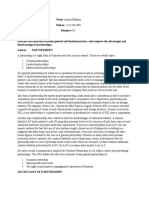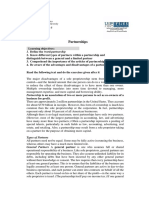0% found this document useful (0 votes)
79 views3 pagesTLE M9 Week 11 Learning Material
This document is a learning module on partnerships for an entrepreneurship class. It discusses the different types of partnerships, including general partnerships and limited partnerships. It explains the key aspects of a partnership agreement and highlights both the advantages and disadvantages of the partnership form of business ownership. The advantages include ease of formation, pooling of knowledge and skills, more sources of capital, and the ability to attract employees. The disadvantages include unlimited liability, limited life, potential conflicts between partners, and difficulty dissolving the business.
Uploaded by
Mixengxeng Ü EspinosaCopyright
© © All Rights Reserved
We take content rights seriously. If you suspect this is your content, claim it here.
Available Formats
Download as DOCX, PDF, TXT or read online on Scribd
0% found this document useful (0 votes)
79 views3 pagesTLE M9 Week 11 Learning Material
This document is a learning module on partnerships for an entrepreneurship class. It discusses the different types of partnerships, including general partnerships and limited partnerships. It explains the key aspects of a partnership agreement and highlights both the advantages and disadvantages of the partnership form of business ownership. The advantages include ease of formation, pooling of knowledge and skills, more sources of capital, and the ability to attract employees. The disadvantages include unlimited liability, limited life, potential conflicts between partners, and difficulty dissolving the business.
Uploaded by
Mixengxeng Ü EspinosaCopyright
© © All Rights Reserved
We take content rights seriously. If you suspect this is your content, claim it here.
Available Formats
Download as DOCX, PDF, TXT or read online on Scribd
/ 3
















































































































